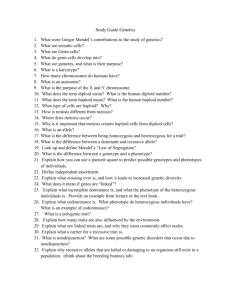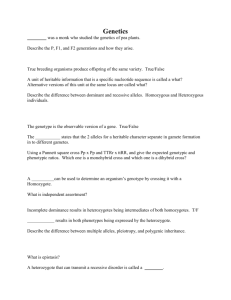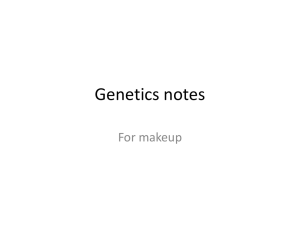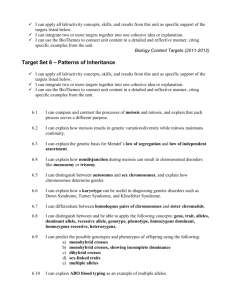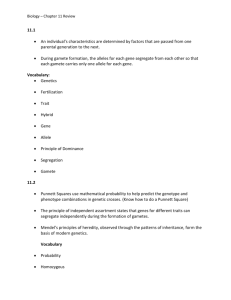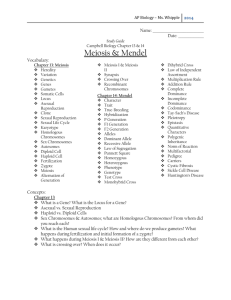Chapter 6 & 7 Overview Define: Somatic cell, gamete, homologous
advertisement
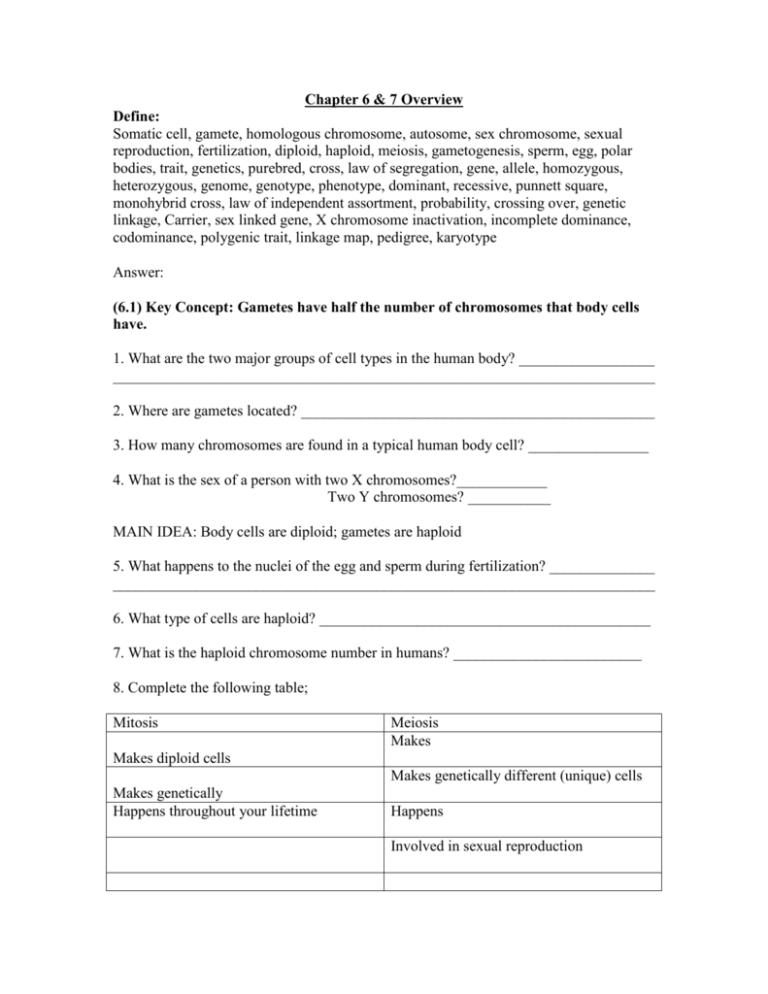
Chapter 6 & 7 Overview Define: Somatic cell, gamete, homologous chromosome, autosome, sex chromosome, sexual reproduction, fertilization, diploid, haploid, meiosis, gametogenesis, sperm, egg, polar bodies, trait, genetics, purebred, cross, law of segregation, gene, allele, homozygous, heterozygous, genome, genotype, phenotype, dominant, recessive, punnett square, monohybrid cross, law of independent assortment, probability, crossing over, genetic linkage, Carrier, sex linked gene, X chromosome inactivation, incomplete dominance, codominance, polygenic trait, linkage map, pedigree, karyotype Answer: (6.1) Key Concept: Gametes have half the number of chromosomes that body cells have. 1. What are the two major groups of cell types in the human body? __________________ ________________________________________________________________________ 2. Where are gametes located? _______________________________________________ 3. How many chromosomes are found in a typical human body cell? ________________ 4. What is the sex of a person with two X chromosomes?____________ Two Y chromosomes? ___________ MAIN IDEA: Body cells are diploid; gametes are haploid 5. What happens to the nuclei of the egg and sperm during fertilization? ______________ ________________________________________________________________________ 6. What type of cells are haploid? ____________________________________________ 7. What is the haploid chromosome number in humans? _________________________ 8. Complete the following table; Mitosis Meiosis Makes Makes diploid cells Makes genetically different (unique) cells Makes genetically Happens throughout your lifetime Happens Involved in sexual reproduction 9. Draw a picture of a homologous chromosomes (6.2) KEY CONCEPT: During meiosis, diploid cells undergo two cell divisions that result in haploid cells. Cells go through two rounds of division in meiosis.\ 10. After a chromosome is replicated, each half is called a ____________________. 11. Sketch the phases of meiosis I and II label the name of each phase (use fig. 6.5 to help you) 12. What does a sperm cell contribute to an embryo? ______________________ 13. What does an egg cell contribute to an embryo? _______________________ (6.3) KEY CONCEPT: Mendel’s research showed that traits are inherited as discrete units. 14. Describe the study of Genetics? ___________________________________________ ________________________________________________________________________ 15. How did Mendel’s views on inheritance differ from the views of many scientists of his time?________________________________________________________________ ________________________________________________________________________ 16. Why did Mendel use pea plants? _________________________________________ 17. Describe Mendel’s Law of Segregation_____________________________________ ________________________________________________________________________ (6.4) Key concept: Genes encode proteins that produce a diverse range of traits. 18. What is the relationship between genes and proteins? __________________________ ________________________________________________________________________ 19. What is an allele? ______________________________________________________ 20. What does phenotype mean? ____________________________________________ Give an example of a phenotypic characteristic ___________________________ 21. What does genotype mean? _____________________________________________ Give an example of a genotypic characteristic____________________________ 22. How are alleles represented on paper? ___________________________________ A capital letter represents a __________________allele A lowercase letter represents a _______________allele 23. Complete the table: Genotype Homozygous dominant Phenotype Alleles Recessive Tt 24. What is the alternative form of a gene?______________________________ 25. What is the opposite of heterozygous? ______________________________ 26. What is the opposite of recessive? _________________________________ (6.5) KEY CONCEPT: The inheritance of traits follows the rules of probability 27. Draw a picture of a Punnett square & LABEL the parts 28. Draw a punnet square for a homozygous recessive parent (ff) who breeds with a Heterozygous parent (Ff). (6.6) KEY CONCEPT; Independent assortment and crossing over during meiosis result in genetic diversity 29. What are two ways that sexual reproduction helps create and maintain genetic diversity? ______________________________________________________________ _______________________________________________________________________ 30. Which does sexual reproduction create; New alleles OR new combinations of alleles? _______________________________________________________________________ 31. How is the production of unique genetic combinations an advantage to organisms of a species? _______________________________________________________________ 32. Draw a picture of Crossing over. Use figure 6.20 on page 190 to help you. 33. Summarize Mendel’s three basic laws; a. ________________________________________________________________ ________________________________________________________________________ b. ________________________________________________________________ ________________________________________________________________________ c. ________________________________________________________________ ________________________________________________________________________ (7.1) KEY CONCEPT: The chromosomes on which genes are located can affect the expression of traits. 34. What are sex chromosomes? ____________________________________________ 35. What are autosomes? __________________________________________________ 36. How is a carrier different from a person who has a genetic disorder? _____________ _______________________________________________________________________ 37. How are sex-linked genes expressed differently in the phenotypes of males and females? _______________________________________________________________ ______________________________________________________________________ 38. Describe three factors that may affect phenotype a. Incomplete dominance_____________________________________________ _______________________________________________________________________ Give an example of incomplete dominance_________________________ ________________________________________________________________________ b. Co-dominance____________________________________________________ ________________________________________________________________________ Give an example of Co-dominance________________________________ ________________________________________________________________________ c. Polygenic Trait___________________________________________________ _______________________________________________________________________ Give an example of polygenic traits______________________________ (7.4) KEY CONCEPT: A combination of methods is used to study human genetics 39. How does genetic inheritance follow similar patterns in all sexually reproducing organisms? __________________________________________________________ 40. Who can be carriers of autosomal disorders? ______________________________ _____________________________________________________________________ 41. Why are some sex-linked diseases only expressed in males? ____________________ ________________________________________________________________________ 42. What is a pedigree? ________________________________________________ 43. What is a Karyotype? _________________________________________________
